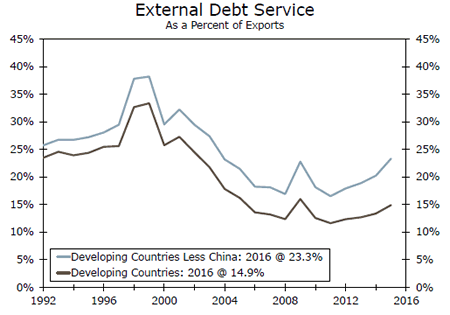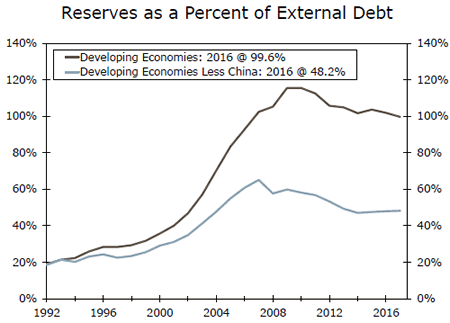U.S. Review
Consumer Remains on Solid Footing
- There were two key takeaways from economic data released this week. First, current economic conditions are positive for the U.S. consumer, who remain confident about the labor market providing opportunity for continued income growth, and are comfortable making economic decisions accordingly.
- Second, disappointment may be setting in for those expecting a strong rebound in the factory sector. Tax cuts and other public policy expectations have not come to fruition as soon as some had hoped following the election. Data show a recovery, but it is slow and gradual. Orders and shipments data have yet to signal a major pickup for the factory sector is imminent.
Reality Sets In
The U.S. economy expanded 1.4 percent in the first quarter of the year, which was a larger-than-expected upgrade in the final look at GDP this week. The improvement was largely on the personal consumption line, which actually rose 1.1 percent in Q1, much stronger than the 0.3 percent first estimated. Still somewhat soft relative to recent performance, the consumption portion of the U.S. economy had a decent start to the year, which adds to our confidence that Q2 GDP will get a solid boost from consumption.
Surveys of consumers continue to support expectations of a solid Q2 performance for consumption. The Conference Board’s Survey of Consumer Confidence in June confirmed an upbeat assessment of the present economic situation. The measure has surged over the past six months, hitting a cycle high in March. Headline consumer confidence gave back some of that gain in subsequent months on diminishing strength in the expectations component. Consumers’ assessment of their current economic situation has continued its steady climb upward. Progress toward the policy objectives that had boosted expectations in the first months of the new administration has likely been slower than some anticipated. Although some disappointment may have set in, the economic reality—the labor market in particular—is getting positive reviews from an increasing share of consumers surveyed.
Consumers’ positive assessment of their current situation was reinforced by the continued strength seen in personal income growth. Personal income rose another 0.4 percent in May, besting expectations of 0.3 percent. Disposable income was up a strong 0.5 percent, and was even stronger in real terms as the lack of price pressures, particularly at the gas pump, left more money in consumers’ pocket in May. The PCE deflator declined 0.1 percent on the month, continuing a string of soft inflation prints. The PCE deflator is followed closely by the Fed, and the year-over-year increase of 1.4 percent in both headline and core PCE is quite far from the FOMC target of 2 percent.
Manufacturing activity has yet to ramp up significantly, as had been suggested by sentiment measures from the sector early in the year. To be sure, factories are faring far better than this time last year and continue to pull themselves out of the rout that had plagued the sector for nearly two years. Continued uncertainty surrounding trade, health care and tax reform appears to have diminished expectations in the business sector, which appear to be holding off investment spending, which weighs on demand from U.S. factories. The second quarter started off slow, with new orders down 1.1 percent in May, declining for the second month. Core capital goods, which exclude defense and aircraft and provide a useful proxy for business investment in GDP, have softened. Shipments of core goods declined 0.2 percent in May, and orders also declined, suggesting a significant bounce by the end of Q2 is unlikely. Both orders and shipments of core goods are running at the softest three month annualized rate of 2017. The convergence of soft and hard data at a lower level of activity enforces our call that the factory sector is in for a slow and steady improvement, at least until some clarity emerges on fiscal policy.
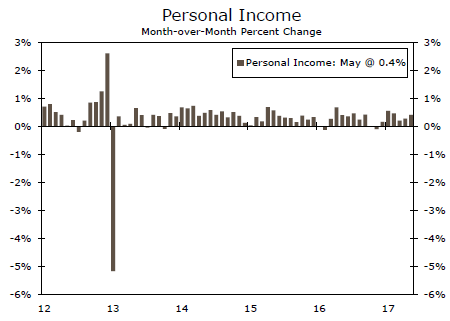
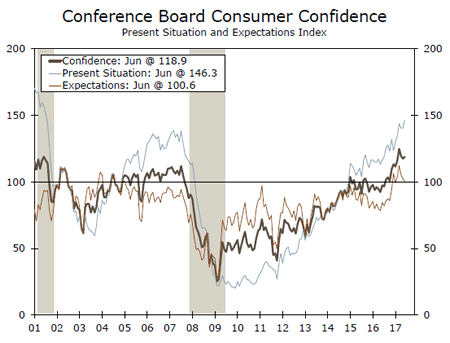
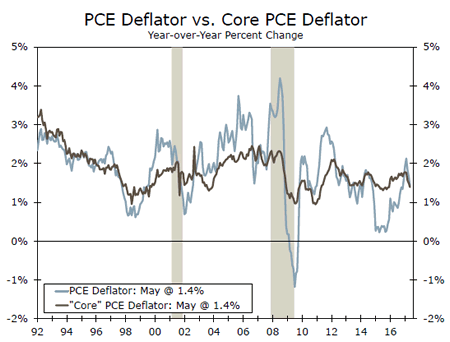
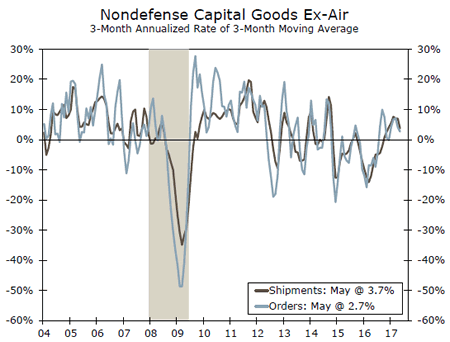
U.S. Outlook
ISM Manufacturing • Monday
The ISM manufacturing index has hovered just shy of 55 over the past two months, a modest pullback from levels seen in Q1. The new orders and production components were a solid 59.5 and 57.1, respectively, in May, but both of these readings were below their six-month averages. This softening in new orders and production has corresponded with a deceleration in the hard data for capital goods orders. Encouragingly, after seven straight months of sub-50 readings for the backlog of orders component, this measure of activity in the pipeline snapped the streak in February and has held steady in the mid-50s since.
We expect the ISM index to remain near the 55 mark in June. While this is lower than the robust readings registered to start the year, it is still consistent with incremental improvement in the manufacturing sector relative to the past couple years; the ISM index remained below the 55 mark for all of 2015 and 2016.
Previous: 54.9 Wells Fargo: 55.0 Consensus: 55.0
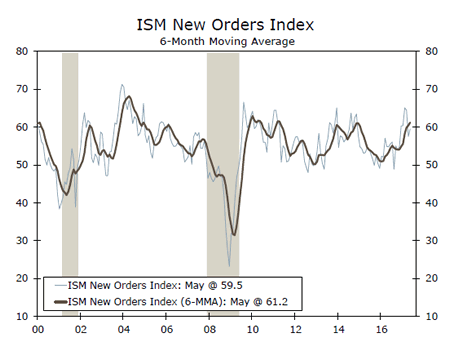
Trade Balance • Thursday
The trade deficit widened to start Q2, as imports rose strongly while exports edged down. A decline in automobiles and parts and consumer goods exports weighed, leading to the second consecutive month the value of exports declined. Imports were boosted by a surge in consumer goods and cell phones in particular.
Unless exports bounce back strongly in May and June, sequential growth in real exports of goods and services likely will be weak in Q2. On the other hand, sequential growth in real imports likely will be fairly solid in the second quarter. In other words, real net exports likely will exert a modest drag on overall real GDP growth in the current quarter. We expect that export growth generally will remain positive going forward, although it likely will fall short of import growth. As illustrated in the middle chart, trade in real goods has accelerated as economic growth has firmed both domestically and abroad.
Previous: -$47.6B Wells Fargo: -$46.1B Consensus: -$46.2B
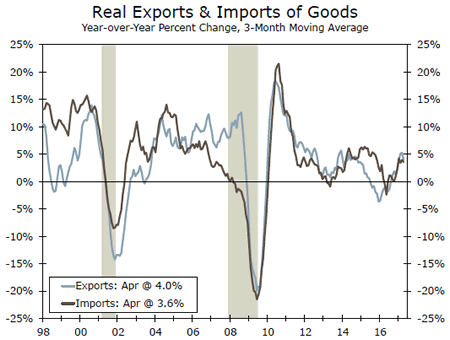
Employment • Friday
On trend, nonfarm employment growth has gradually been slowing since early 2015, as slack in the labor market continues to diminish and secular demographic headwinds limit growth in the labor force. Of late, the retail sector has been a major drag on employment growth, shedding 52,000 jobs over just the past three months. Education & health, leisure & hospitality and professional & business services have led job growth.
With the unemployment rate at a cycle-low of 4.3 percent and employment gradually decelerating, the attention on wage growth (or lack thereof) continues to grow. Average hourly wage growth remains well below the peak of previous cycles amid relatively benign inflation and sluggish labor productivity growth. With job openings at a record high and survey data suggesting positions are increasingly hard to fill, the stage is set for somewhat faster wage growth later this year.
Previous: 138,000 Wells Fargo: 170,000 Consensus: 177,000
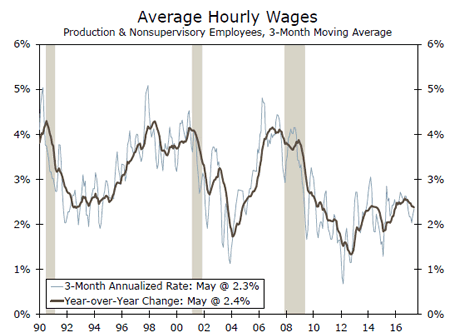
Global Review
Confidence Abounds in the Eurozone
- Confidence indicators are surging across the Eurozone. Although indices of business and consumer confidence appear to be overstating the underlying pace of growth at present, the economic expansion that is underway in the euro area appears to be increasingly self-sustaining.
Japanese Economy Continues to Grind Along
- The modest pace of expansion that has been underway in Japan appears to have continued in Q2. Until inflation moves higher, however, the Bank of Japan (BOJ) likely will keep its foot firmly on the accelerator of monetary accommodation.
Confidence Abounds in the Eurozone
If confidence indicators are to be believed, the Eurozone economy is booming at present. As shown in the bottom chart on page 1, the Ifo index of German business sentiment rose to 115.1 in June, the highest reading in at least 26 years, and consumer confidence in Germany reached a 16-year high. Consumer confidence in France shot up to a 10-year high in June, no doubt spurred higher by the election of President Macron in May and his impressive legislative win earlier this month. The Italian index of consumer confidence also moved higher during the month.
That said, confidence indicators have consistently overstated the underlying strength of the Eurozone economy in recent years. Industrial production (IP) in Germany was up 2.3 percent in the February-April period relative to the same three-month period last year (see graph on page 1). This growth rate in German IP is solid, but it is hardly reflective of "boom." Strength in French consumer confidence has yet to translate into robust growth in French consumer spending on a sustained basis (top chart).
The Eurozone economy may not be exactly "booming," but it does seem that the current economic expansion, which has been underway now for four years, is becoming increasingly selfsustaining. Indeed, ECB President Draghi gave a speech this week in which he talked about the broadening and the strengthening in the Eurozone economic recovery. But he also noted that inflation in the overall euro area remains well below the ECB’s target of "below, but close to, 2 percent over the medium term." Although the ECB may further "taper" its quantitative easing program later this year, we continue to believe that the Governing Council will refrain from raising interest rates until well into 2018.
Japanese Economy Continues to Grind Along
Data released this week indicate that the Japanese economy, where real GDP was up 1.3 percent on a year-over-year basis in Q1 2017, continues to grow at a modest pace. Japanese IP dropped 3.3 percent in May relative to the previous month, which, on the surface, looks awful. However, the plunge in IP in May was not sharp enough to reverse the 4.0 percent jump that was registered in April. Moreover, the year-over-year growth rate, which is shown in the middle chart, is more reflective of the underlying trend in Japanese IP at present. A similar monthly pattern (i.e., strength in April followed by relative weakness in May) was also observed in Japanese retail spending. On a yearago basis, retail sales in Japan were up 2.0 percent in May.
The pace of economic growth in Japan at present is not strong enough to lift inflation, however. The overall rate of CPI inflation was just 0.4 percent in May, well short of the BoJ’s 2 percent target (bottom chart). Although some foreign central banks are starting to indicate that it may soon be appropriate to remove some monetary accommodation (see "Interest Rate Watch" on page 6), the BoJ seems content to keep its quantitative easing program firmly in place for the foreseeable future. Consequently, we believe that the Japanese yen will remain on the defensive versus most major currencies.
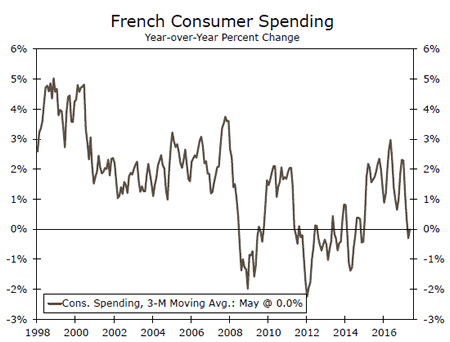
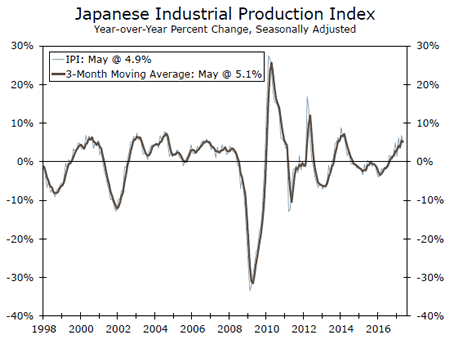
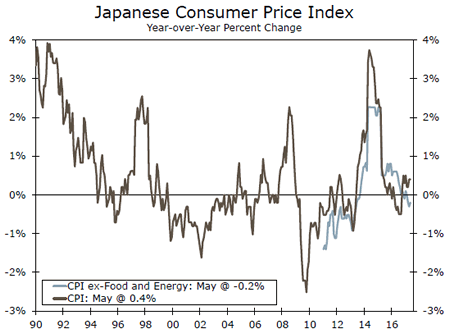
Global Outlook
China Caixin PMIs • Tuesday
The Caixin manufacturing and service PMIs for China will be released early next week. The manufacturing index is expected to remain in contractionary territory, at 49.8, following a May reading of 49.6. The recent pullback in manufacturing activity suggests that the secondary sector, which includes manufacturing, construction and utilities production, softened in Q2, following a strong 6.4 percent growth rate in Q1. The secondary sector accounts for roughly 40 percent of the value added in the Chinese economy, thus markets will be watching this release closely.
The service PMI is also on the docket for next week for the secondlargest economy in the world. China’s service sector expanded at a faster pace in May, indicating renewed momentum in the sector after deceleration in the previous four months. The divergent trends in the PMI indices will be closely monitored if they widen further.
Previous: Manufacturing (49.6); Services (52.8) Consensus: Manufacturing (49.8)
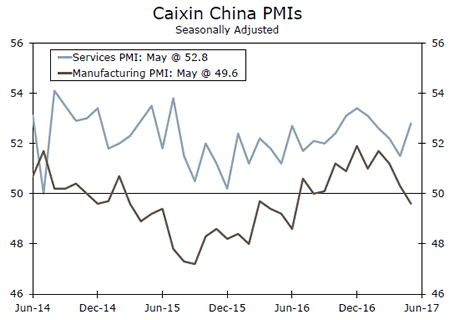
Eurozone Retail Sales • Wednesday
Next Wednesday, retail sales for May are set to be released for the euro area. Economic activity has been gaining momentum in the Eurozone, indicating that economic growth in the area is becoming self-sustaining. Eurozone GDP expanded 1.9 percent in Q1 (year over year) and is expected to increase 1.8 percent in Q2. Retail sales in Germany, the largest economy in the euro area, grew 4.8 percent year-over-year in May, according to data released this morning. In Spain, retail sales grew 3.8 percent in May on a year-over-year basis, its quickest pace since November 2016.
Sentiment indicators in the Eurozone are quite strong at present and the hard data seem to be catching up with the feelings of economic optimism. In fact, this past week, Mario Draghi noted the strengthening character of the Eurozone recovery and recognized that the factors restraining inflation are temporary, and suggested that continued monetary policy would become less accommodative.
Previous: 0.1% (Month-over-Month) Consensus: 0.4% (Month-over-Month)
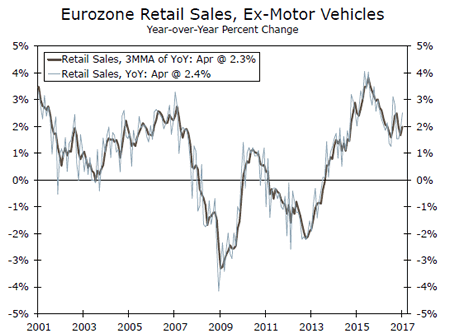
U.K. Industrial Production • Friday
U.K. industrial production (IP) data for May is slated to be released next Friday. IP increased 0.2 percent in April and is expected to increase 0.4 percent in May, on a month-over-month basis. The 0.2 percent gain in April fell well short of the 0.7 percent consensus forecast. Factory output rose 0.2 percent, missing the 0.8 percent expected gain. The weaker-than-expected figures cause a bit of concern, especially in the wake of the general election results in which the governing Conservative Party lost seats in parliament—a result which likely weakened its position in the Brexit negotiations.
Also scheduled for a Friday release are manufacturing production and construction output. All three indicators, taken together, will present a more complete picture of production in the U.K. GDP is expected to increase 1.7 percent in Q2, year over year, a slowdown from the 2.0 percent growth in Q1.
Previous: 0.2% Consensus: Consensus: 0.4% (Month-over-Month)
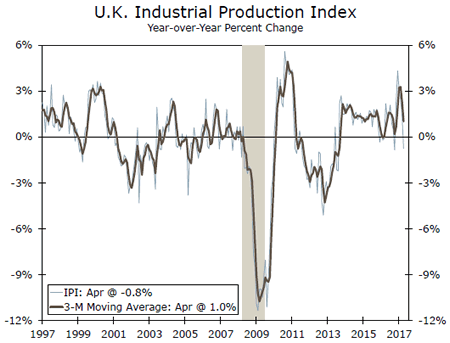
Point of View
Interest Rate Watch
Sovereign Bonds Reverse Course
Yields on longer-dated Treasury securities jumped this week, with the 10-year up 13 bps from last Friday and the 10yr/2yr spread steepening (top chart).
The decline in Treasuries largely began after European Central Bank President Mario Draghi delivered some hawkish language this week that hinted at a reversal of ECB stimulus amid a broadening recovery and budding reflation in the euro area. European sovereign debt sold off in reaction, with the yield on the 10-year German Bund rising 20 bps this week (middle chart). ECB officials attempted to tamp down the rhetoric in subsequent statements, but the damage had already been done. As we have noted in previous reports, the expansion in Europe is increasingly self-sustaining, and our forecast looks for real GDP in the Eurozone to accelerate modestly in coming quarters.
The case for a more hawkish stance from the world’s central banks was not limited to just Europe. After a run of better-thanexpected economic indicators and a solid print for GDP growth in Q1, Canada’s first step toward monetary policy normalization could come as soon as July. The last time the BoC adjusted its benchmark overnight rate was in July 2015 when it cut the overnight rate to 0.50 percent, where it has remained subsequently. Until recently, we expected the Bank of Canada to remain on hold, but we think a quarter point rate hike at the July 12 meeting is now the more likely course of action.
Economic data in the U.S. this week were also generally supportive of higher rates. Despite a miss in durables goods orders, consumer confidence surprised to the upside. The present situation component surged to 146.3; this reading marked the most upbeat assessment by consumers of their current situation since 2001 (bottom chart). Real GDP growth in the United States was also revised higher yesterday, buoyed by another upward revision to personal consumption growth. We look for generally solid U.S. economic data next week as well, including another cycle-low for the unemployment rate, to signal stronger growth ahead for bondholders.
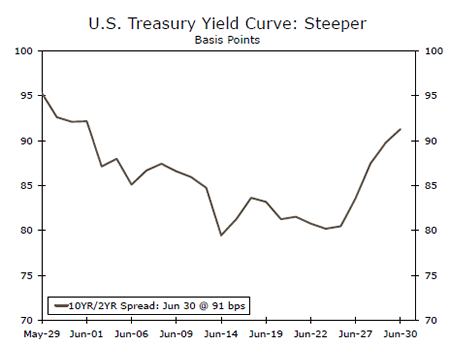
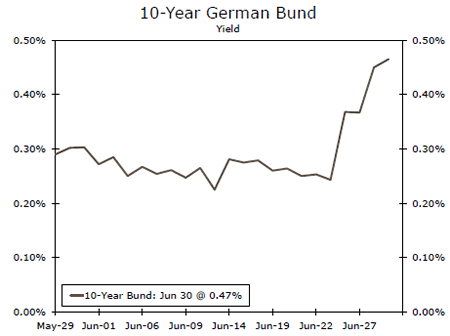
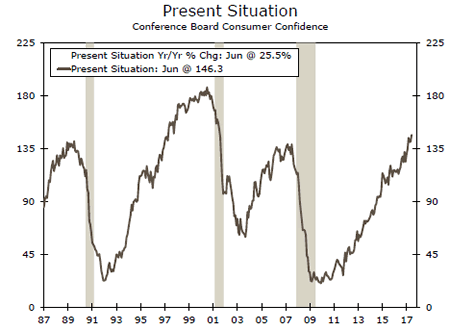
Credit Market Insights
Cloud Looms Over Consumers’ Expectations and Confidence
The Federal Reserve Bank of New York published the results from its May 2017 Survey of Consumer Expectations (SCE), which offers data on consumers’ experiences and expectations related to credit demand and credit access. The monthly results showed that households’ expectation of inflation declined on a oneyear and three-year ahead horizon. Inflation uncertainty one- and three-year ahead remains at a series low.
Consumers’ expectations of their future financial situation and spending growth, however, worsened compared to the previous month. In addition, consumers are expecting home prices to rise 3.5 percent higher. The lack of inventory continues to apply upward pressure on home prices and is starting to weigh on sales. However, with low mortgage rates and strong buyer traffic we expect demand to remain elevated as more homes are put up on the market.
Despite fewer signs of future-optimism, consumer confidence remains elevated as consumers feel positive about the economy today and upbeat about the labor market. The downward trend of future expectations appears, in our opinion, to be from the uncertainty surrounding public policy. That said, the Fed pays attention more to the direction of inflation expectations. With weakening inflation expectations, a case could be made against a September rate hike.
Topic of the Week
Developing Country Debt
External debt in the developing economies has risen noticeably over the past few years, growing to more than $6 trillion in 2014 from less than $4 trillion in 2009. Although the outstanding debt stock has subsequently edged lower, most of that decline is attributable to China, where external debt dropped from nearly $1 trillion in 2014 to about $500 billion last year. Excluding China, the amount of external debt in our sample of countries remains near its 2014 peak. The unsustainable buildup in external debt in the 1990s was partially responsible for the series of financial crises that swept through the developing world in 1997-1998— should we be worried?
It is important to note that countries get into financial difficulties not so much because of the outstanding amount of debt per se, but rather because of their inability to service that debt. Debt service is the amount of interest and amortization payments that a country needs to pay every year, and as a country’s debt service ratio rises, its ability to adequately service its external debts declines, everything else equal. As shown in the top graph, the ratio of debt service payments to exports for the 21 economics in our sample stood at roughly 26 percent in 1997. The ratio has edged closer to this point over the past few years due to the buildup in external debt and slow growth in exports. Nevertheless, the ratio today for the non-Chinese developing economies remains below its 1997 level. In other words, the ability of developing economies to service their external debt is better today than it was 20 years ago.
Furthermore, developing economies have deeper pockets today than they did in 1997. External debt is a liability for developing economies. But they also have assets, namely foreign exchange (FX) reserves, which can be used to service the debt. In that regard, the FX reserves of the 21 economies in our sample mushroomed to roughly $5.8 trillion at the end of 2016 from $500 billion in 1997. In short, the ability of the developing world to service its external debt is generally stronger today than it was at the onset of the so-called Asian financial crisis. A reoccurrence of the financial crises in 1997-98 does not appear to be imminent.
